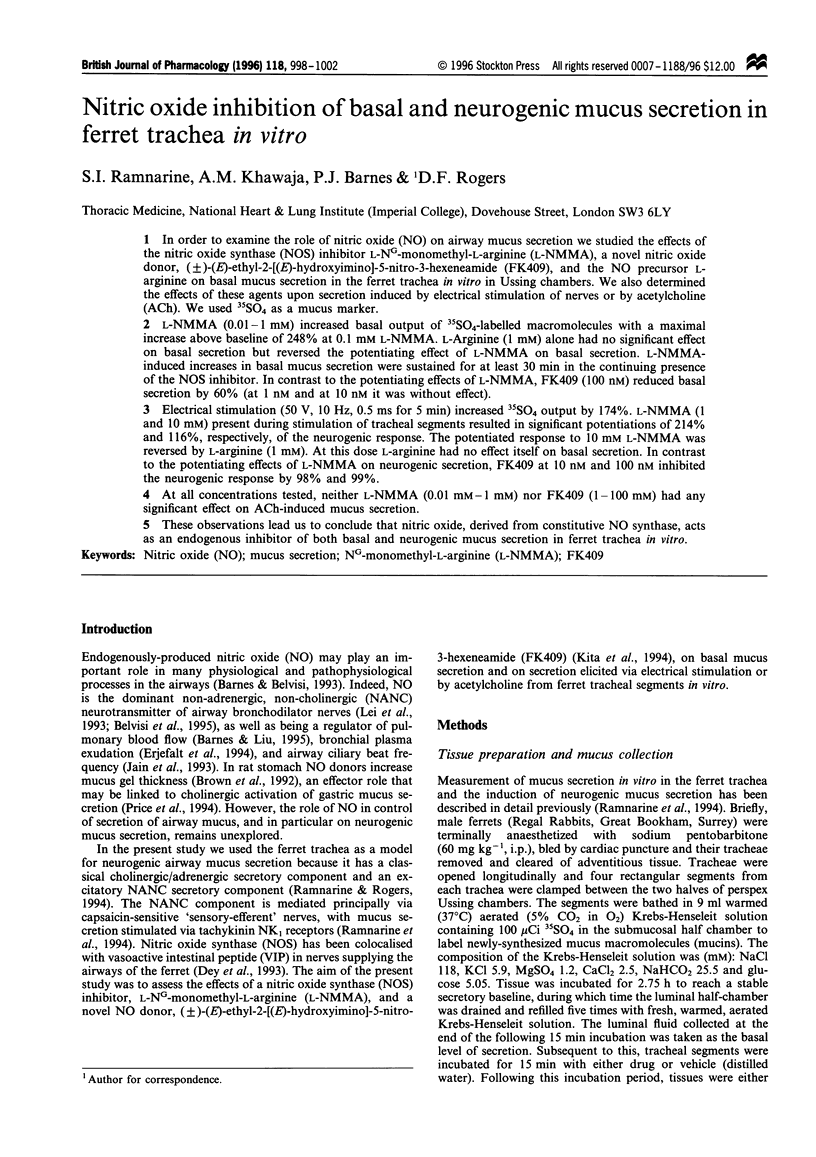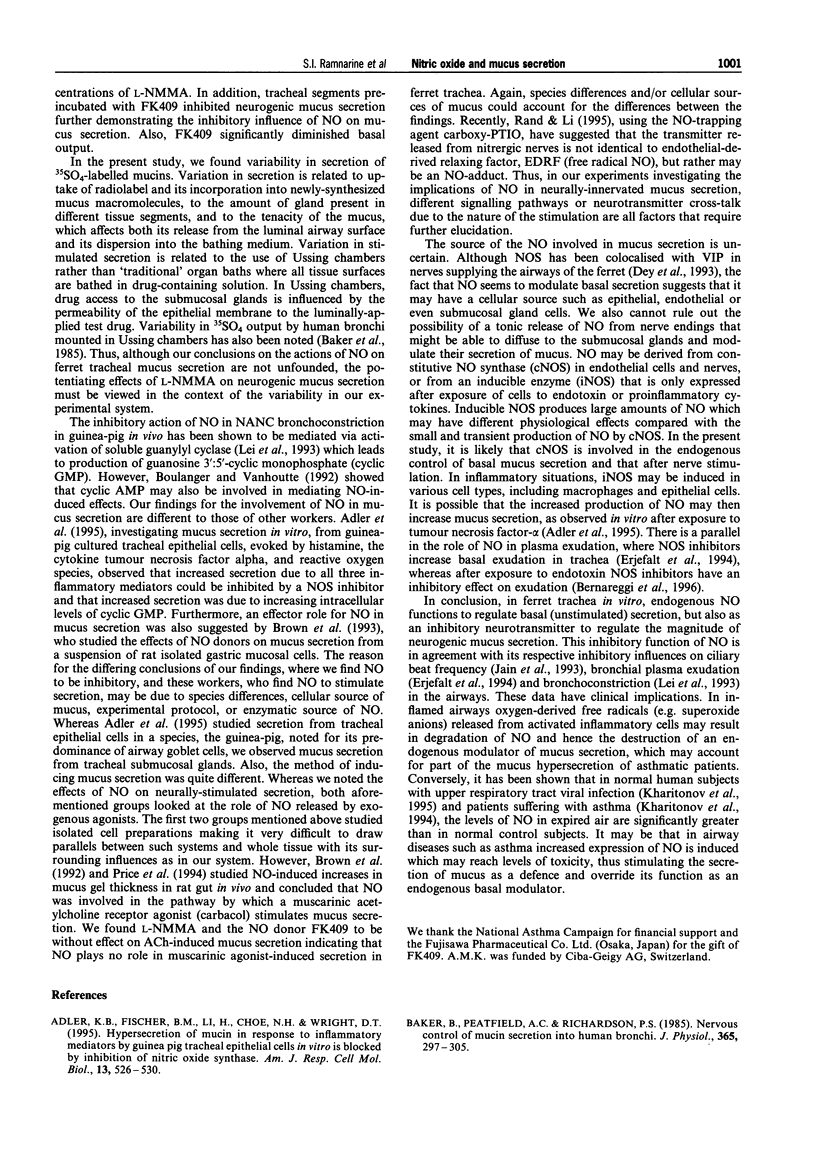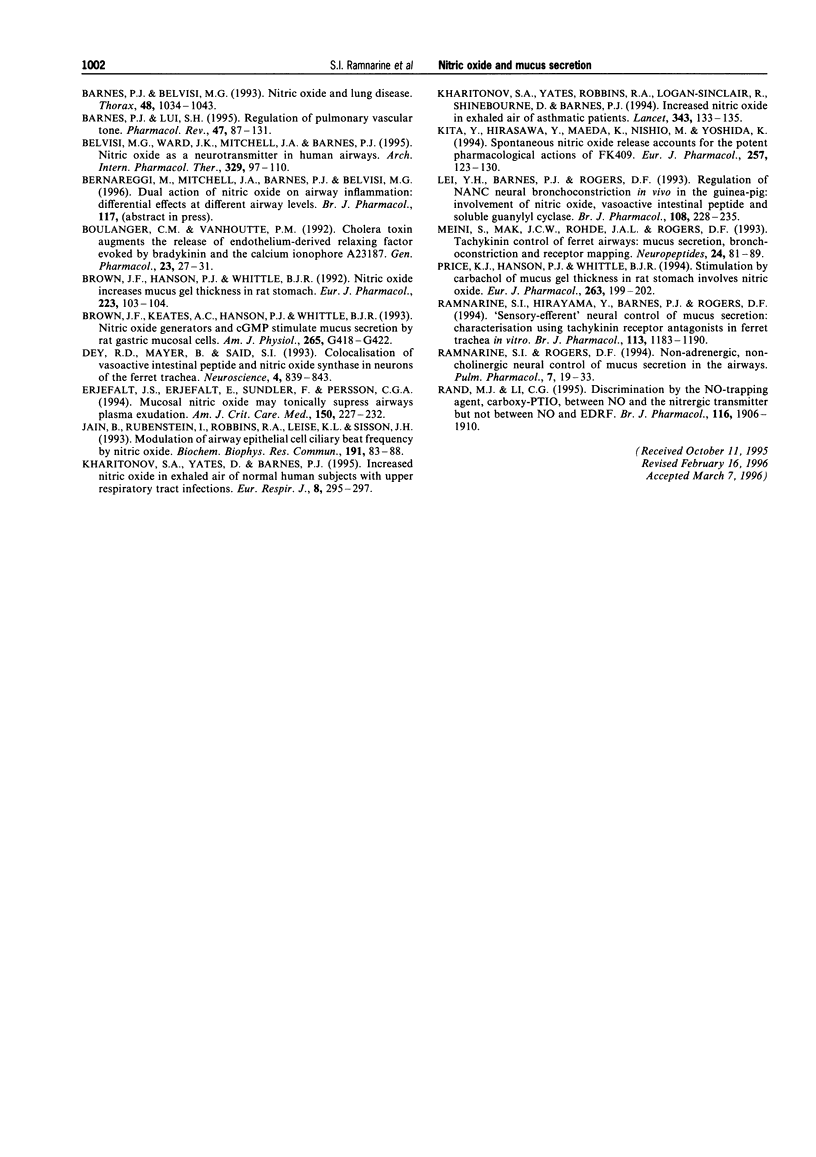Abstract
1. In order to examine the role of nitric oxide (NO) on airway mucus secretion we studied the effects of the nitric oxide synthase (NOS) inhibitor L-N(G)-monomethyl-L-arginine (L-NMMA), a novel nitric oxide donor, (+/-)-(E)-ethyl-2-[(E)-hydroxyimino]-5-nitro-3-hexeneamide (FK409), and the NO precursor L-arginine on basal mucus secretion in the ferret trachea in vitro in Ussing chambers. We also determined the effects of these agents upon secretion induced by electrical stimulation of nerves or by acetylcholine (ACh). We used 35SO4 as a mucus marker. 2. L-NMMA (0.01-1 mM) increased basal output of 35SO4-labelled macromolecules with a maximal increase above baseline of 248% at 0.1 mM L-NMMA. L-Arginine (1 mM) alone had no significant effect on basal secretion but reversed the potentiating effect of L-NMMA on basal secretion. L-NMMA-induced increases in basal mucus secretion were sustained for at least 30 min in the continuing presence of the NOS inhibitor. In contrast to the potentiating effects of L-NMMA, FK409 (100 nM) reduced basal secretion by 60% (at 1 nM and at 10 nM it was without effect). 3. Electrical stimulation (50 V, 10 Hz, 0.5 ms for 5 min) increased 35SO4 output by 174%. L-NMMA (1 and 10 mM) present during stimulation of tracheal segments resulted in significant potentiations of 214% and 116%, respectively, of the neurogenic response. The potentiated response to 10 mM L-NMMA was reversed by L-arginine (1 mM). At this dose L-arginine had no effect itself on basal secretion. In contrast to the potentiating effects of L-NMMA on neurogenic secretion, FK409 at 10 nM and 100 nM inhibited the neurogenic response by 98% and 99%. 4. At all concentrations tested, neither L-NMMA (0.01 mM-1 mM) nor FK409 (1-100 mM) had any significant effect on ACh-induced mucus secretion. 5. These observations lead us to conclude that nitric oxide, derived from constitutive NO synthase, acts as an endogenous inhibitor of both basal and neurogenic mucus secretion in ferret trachea in vitro.
Full text
PDF




Selected References
These references are in PubMed. This may not be the complete list of references from this article.
- Adler K. B., Fischer B. M., Li H., Choe N. H., Wright D. T. Hypersecretion of mucin in response to inflammatory mediators by guinea pig tracheal epithelial cells in vitro is blocked by inhibition of nitric oxide synthase. Am J Respir Cell Mol Biol. 1995 Nov;13(5):526–530. doi: 10.1165/ajrcmb.13.5.7576687. [DOI] [PubMed] [Google Scholar]
- Baker B., Peatfield A. C., Richardson P. S. Nervous control of mucin secretion into human bronchi. J Physiol. 1985 Aug;365:297–305. doi: 10.1113/jphysiol.1985.sp015773. [DOI] [PMC free article] [PubMed] [Google Scholar]
- Barnes P. J., Belvisi M. G. Nitric oxide and lung disease. Thorax. 1993 Oct;48(10):1034–1043. doi: 10.1136/thx.48.10.1034. [DOI] [PMC free article] [PubMed] [Google Scholar]
- Barnes P. J., Liu S. F. Regulation of pulmonary vascular tone. Pharmacol Rev. 1995 Mar;47(1):87–131. [PubMed] [Google Scholar]
- Belvisi M. G., Ward J. K., Mitchell J. A., Barnes P. J. Nitric oxide as a neurotransmitter in human airways. Arch Int Pharmacodyn Ther. 1995 Jan-Feb;329(1):97–110. [PubMed] [Google Scholar]
- Boulanger C. M., Vanhoutte P. M. Cholera toxin augments the release of endothelium-derived relaxing factor evoked by bradykinin and the calcium ionophore A23187. Gen Pharmacol. 1992 Jan;23(1):27–31. doi: 10.1016/0306-3623(92)90042-i. [DOI] [PubMed] [Google Scholar]
- Brown J. F., Hanson P. J., Whittle B. J. Nitric oxide donors increase mucus gel thickness in rat stomach. Eur J Pharmacol. 1992 Nov 13;223(1):103–104. doi: 10.1016/0014-2999(92)90824-n. [DOI] [PubMed] [Google Scholar]
- Brown J. F., Keates A. C., Hanson P. J., Whittle B. J. Nitric oxide generators and cGMP stimulate mucus secretion by rat gastric mucosal cells. Am J Physiol. 1993 Sep;265(3 Pt 1):G418–G422. doi: 10.1152/ajpgi.1993.265.3.G418. [DOI] [PubMed] [Google Scholar]
- Dey R. D., Mayer B., Said S. I. Colocalization of vasoactive intestinal peptide and nitric oxide synthase in neurons of the ferret trachea. Neuroscience. 1993 Jun;54(4):839–843. doi: 10.1016/0306-4522(93)90578-4. [DOI] [PubMed] [Google Scholar]
- Erjefält J. S., Erjefält I., Sundler F., Persson C. G. Mucosal nitric oxide may tonically suppress airways plasma exudation. Am J Respir Crit Care Med. 1994 Jul;150(1):227–232. doi: 10.1164/ajrccm.150.1.8025753. [DOI] [PubMed] [Google Scholar]
- Jain B., Rubinstein I., Robbins R. A., Leise K. L., Sisson J. H. Modulation of airway epithelial cell ciliary beat frequency by nitric oxide. Biochem Biophys Res Commun. 1993 Feb 26;191(1):83–88. doi: 10.1006/bbrc.1993.1187. [DOI] [PubMed] [Google Scholar]
- Kharitonov S. A., Yates D., Barnes P. J. Increased nitric oxide in exhaled air of normal human subjects with upper respiratory tract infections. Eur Respir J. 1995 Feb;8(2):295–297. doi: 10.1183/09031936.95.08020295. [DOI] [PubMed] [Google Scholar]
- Kharitonov S. A., Yates D., Robbins R. A., Logan-Sinclair R., Shinebourne E. A., Barnes P. J. Increased nitric oxide in exhaled air of asthmatic patients. Lancet. 1994 Jan 15;343(8890):133–135. doi: 10.1016/s0140-6736(94)90931-8. [DOI] [PubMed] [Google Scholar]
- Kita Y., Hirasawa Y., Maeda K., Nishio M., Yoshida K. Spontaneous nitric oxide release accounts for the potent pharmacological actions of FK409. Eur J Pharmacol. 1994 May 12;257(1-2):123–130. doi: 10.1016/0014-2999(94)90703-x. [DOI] [PubMed] [Google Scholar]
- Lei Y. H., Barnes P. J., Rogers D. F. Regulation of NANC neural bronchoconstriction in vivo in the guinea-pig: involvement of nitric oxide, vasoactive intestinal peptide and soluble guanylyl cyclase. Br J Pharmacol. 1993 Jan;108(1):228–235. doi: 10.1111/j.1476-5381.1993.tb13467.x. [DOI] [PMC free article] [PubMed] [Google Scholar]
- Meini S., Mak J. C., Rohde J. A., Rogers D. F. Tachykinin control of ferret airways: mucus secretion, bronchoconstriction and receptor mapping. Neuropeptides. 1993 Feb;24(2):81–89. doi: 10.1016/0143-4179(93)90025-6. [DOI] [PubMed] [Google Scholar]
- Price K. J., Hanson P. J., Whittle B. J. Stimulation by carbachol of mucus gel thickness in rat stomach involves nitric oxide. Eur J Pharmacol. 1994 Sep 22;263(1-2):199–202. doi: 10.1016/0014-2999(94)90542-8. [DOI] [PubMed] [Google Scholar]
- Ramnarine S. I., Hirayama Y., Barnes P. J., Rogers D. F. 'Sensory-efferent' neural control of mucus secretion: characterization using tachykinin receptor antagonists in ferret trachea in vitro. Br J Pharmacol. 1994 Dec;113(4):1183–1190. doi: 10.1111/j.1476-5381.1994.tb17122.x. [DOI] [PMC free article] [PubMed] [Google Scholar]
- Ramnarine S. I., Rogers D. F. Non-adrenergic, non-cholinergic neural control of mucus secretion in the airways. Pulm Pharmacol. 1994 Feb;7(1):19–33. doi: 10.1006/pulp.1994.1002. [DOI] [PubMed] [Google Scholar]
- Rand M. J., Li C. G. Discrimination by the NO-trapping agent, carboxy-PTIO, between NO and the nitrergic transmitter but not between NO and EDRF. Br J Pharmacol. 1995 Sep;116(2):1906–1910. doi: 10.1111/j.1476-5381.1995.tb16681.x. [DOI] [PMC free article] [PubMed] [Google Scholar]


